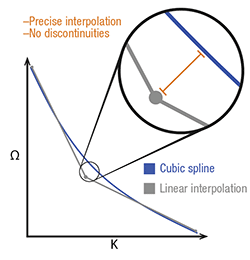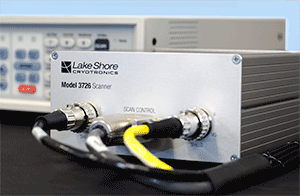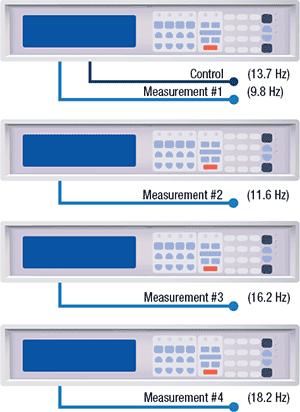More about the Model 372
Targeted applications
Ultra-low temperature measurement
Making measurements below 100 mK is far from a trivial exercise, with even the smallest amounts of added energy leading to self-heating and unwanted temperature shifts. Every design decision made on the Model 372 aims to minimize the amount of energy needed to take measurements.
Noise rejection
Externally generated electronic noise can be a major cause of self-heating if it is allowed to couple into the device under test. Thankfully, multiple noise-rejection strategies have been implemented to reduce this effect substantially:
- Our patented* balanced noise-rejecting current source ensures that external signals have no path to ground through the measurement circuit, effectively making the Model 372 unaffected by these noise sources.
- The measurement signal cables use a driven guard that reduces parasitic capacitance in the cables that connect a scanner to the Model 372. This helps to further balance the measurement network and bolster the integrity of the noise rejection circuitry.
- All measurement circuitry is isolated from other instrument components, limiting the impact of any small electrical disturbances.
- The AC frequency options used for the measurement signal are selected to be naturally resilient to line voltage frequencies (50 and 60 Hz).
AC measurement signals
By using alternating current (AC) measurement in tandem with a specially designed internal lock-in amplifier, the Model 372 is able to extract very small measurement signals from background noise. This allows for much lower excitation levels to be used when compared to traditional direct current (DC) systems, minimizing the amount of energy that is dissipated into the device under test.
These AC excitation levels can be set to as low as 10 pA, while still maintaining accuracy of better than 1% over quite a wide range of resistances. This enables impedance and temperature measurements to be made while adding power levels so small that they are measured in the attowatt range (10-18 W). These features are vital in allowing accurate measurement to be made while minimizing the negative effects of self-heating.
Low noise signal recovery
Due to the very low excitation level used for measurement, the resulting voltage levels must first be boosted to allow those signals to be measured. The internal lock-in amplifier in the Model 372 has been specifically designed to minimize the amount of noise added to the signal. This results in an input noise figure that is less than 10 nV/√Hz, thereby increasing the resolution of measurements and limiting the amount of post-measurement filtering that needs to be applied.
Temperature measurement
 Extremely accurate and reliable ultra-low temperature measurements can be achieved by combining the Model 372 with a negative temperature coefficient (NTC) resistive temperature device (RTD), such as the Lake Shore Cernox®,
Rox™, or germanium temperature sensors. Multiple calibration curves can easily be uploaded to the Model 372, allowing highly accurate conversion of sensor resistance to equivalent temperature using cubic spline interpolation (an improved interpolation technique compared to older instruments).
Extremely accurate and reliable ultra-low temperature measurements can be achieved by combining the Model 372 with a negative temperature coefficient (NTC) resistive temperature device (RTD), such as the Lake Shore Cernox®,
Rox™, or germanium temperature sensors. Multiple calibration curves can easily be uploaded to the Model 372, allowing highly accurate conversion of sensor resistance to equivalent temperature using cubic spline interpolation (an improved interpolation technique compared to older instruments).
User-generated calibration curves can also be created and loaded into the Model 372, allowing great flexibility in the type of resistive sensors that are used. A maximum of 39 calibration curves can be stored on the instrument, and when used with a 3726 scanner, up to 17 sensors can be connected simultaneously, each with its own curve.
Measure a wide range of resistive devices
With up to 22 different current (I) excitation levels available, the Model 372 is able to perform accurate impedance measurements from several microohms (10-6 Ω) to many megohms (106 Ω), all while keeping power dissipation levels to an absolute minimum.
The addition of full quadrature measurements means that both the resistive and reactive components of an impedance can now be measured. This enables much better characterization of the device under test by allowing capacitive or inductive components to be measured.
Backwards compatibility
The Model 372 is designed for trouble-free integration with existing equipment and software that has been built around the previous generation Model 370.
- Emulation mode on the Model 372 is designed to imitate all-important communication functions of the Model 370. In most cases, programming that was previously written for the Model 370 can be used to interact with the Model 372.
- A convenient heater connector adapter (117-071) can also be purchased. This adapter replicates the BNC heater connections that were available on the Model 370, allowing connection swapping between the Model 372 and Model 370 without the need to rewire experiment cabling.
Connectivity and usability—communication options
Physical connectivity
Various methods for communicating with the Model 372 are made available:
- Ethernet: allows full control and reporting throughout an IP network.
- USB: provides direct serial communication by emulating a standard RS-232 connection.
- IEEE-488.2: allows connection to GPIB systems.

Available functions
Multiple actions can be performed when connected to the Model 372 through one of its various remote access options:
- Send any command to the instrument that could be entered via the front panel
- Read and store measurement data that is generated by the instrument
- Live graphical viewing of data using the Lake Shore Cryotronics Chart Recorder software
- Load new calibration curves for use with new temperature sensors
- Upload new firmware if required

Expandability
For situations where temperature measurements must be taken at multiple locations, the 3726 scanner and preamp can be paired with the Model 372 to provide up to 16 connections for 4-wire resistance measurements. The Model 372 can switch measurement to any one of these connections as required, removing the need to physically switch cables on the instrument to look at different sensors. The measurement signal is also boosted by a preamp circuit in the 3726, preserving the signal-to-noise ratio between the sensor and measurement circuitry of the Model 372. This allows connection cables of up to 10 m (33 ft) to be used between the Model 372 and the 3726.

The 3726 scanner option
In cases where measurements are required at multiple locations simultaneously within an experiment space, additional Model 372 units may be used together. Five different AC excitation frequencies are available for this purpose, ensuring that up to five simultaneous measurements can be performed without the risk of co-channel interference.






